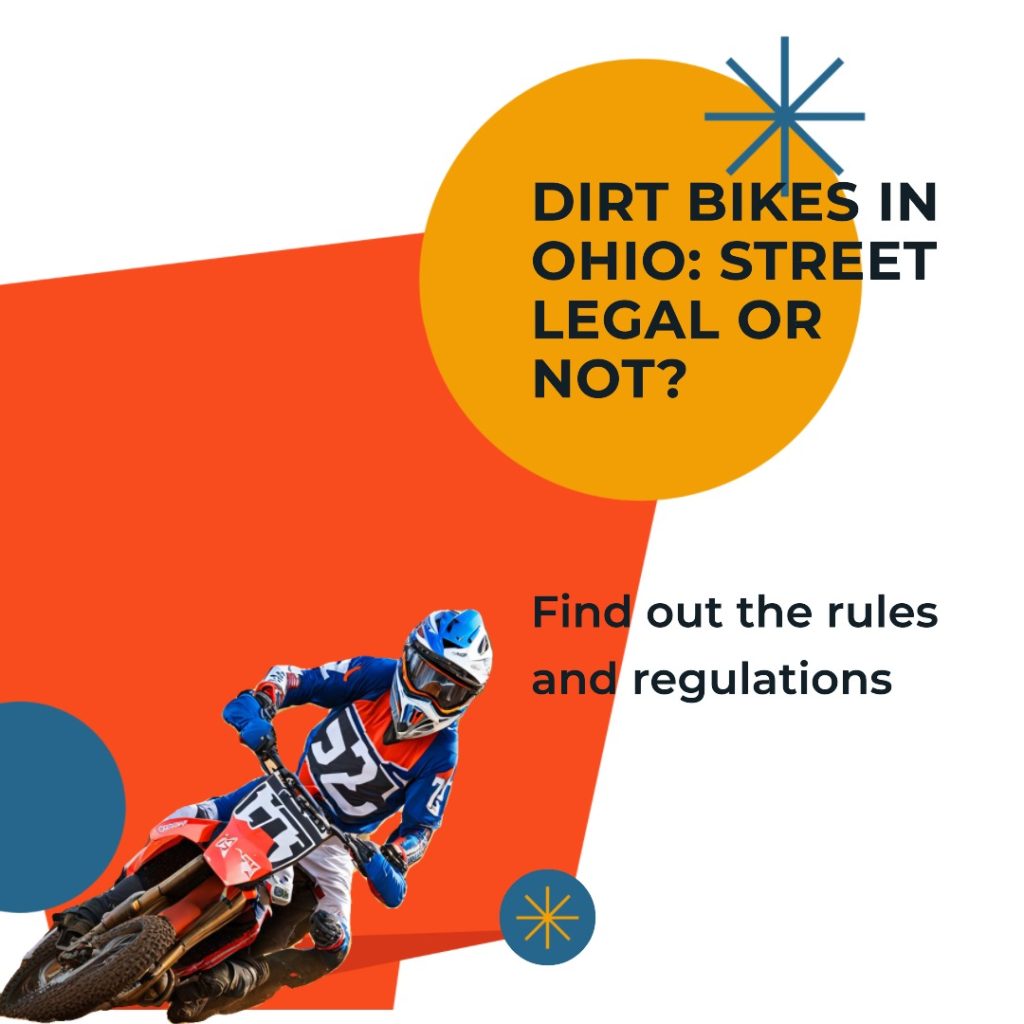In Ohio, dirt bikes are not inherently street-legal due to their design and typical lack of on-road safety features.
However, owners can modify these vehicles to meet state requirements for road use. This guide will outline the regulations governing dirt bike use on Ohio’s streets, detailing how to legally ride and what modifications are necessary.
You will also learn about registration, titling, and insurance obligations for dirt bikes in Ohio.
Understanding these rules is crucial for riders seeking to navigate public roads legally with their off-road motorcycles.
Table of Contents
- 1 Are Dirt Bikes Street Legal in Ohio?
- 2 I. Is it Illegal to Ride Dirt Bikes on Ohio Roads
- 3 II. Where Can You Ride Your Dirt Bikes Legally in Ohio
- 4 III. How to Make a Dirt Bike Street Legal in Ohio
- 5 A. Mechanical Additions to Make a Dirt Bike Street Legal in Ohio
- 6 B. Non-Mechanical Procedures to Make a Dirt Bike Street Legal in Ohio
- 7 Obtaining OHV Decal
- 8 Approval
- 9 Registering the Dirt Bike
- 10 IV. Do Dirt Bikes Have Titles in Ohio
- 11 V. Do You Need a License and Liability Insurance to Ride a Dirt Bike in Ohio
- 12 Conclusion
- 13 Conclusion
Are Dirt Bikes Street Legal in Ohio?

Overview of dirt bikes and their popularity in Ohio
To understand the popularity of dirt bikes in Ohio, it’s important to take a closer look at their usage and appeal among riders in the state.
Dirt bikes are off-road motorcycles designed specifically for riding on rough terrains such as dirt tracks, trails, and motocross circuits.
They’re equipped with powerful engines, lightweight frames, and knobby tires to provide optimal performance in off-road conditions.
In Ohio, dirt bikes have gained significant popularity among thrill-seeking riders who enjoy the adrenaline rush and challenges that off-road riding offers.
The state offers a variety of off-road trails and tracks, which attract riders of all skill levels.
Additionally, dirt bike events and competitions are regularly held in Ohio, further contributing to their popularity.
The versatility and excitement provided by dirt bikes make them a favorite choice for many riders in Ohio.
Explanation of street legal status and regulations in the state
Understanding the legality of dirt bikes on Ohio’s streets requires an examination of the state’s regulations and guidelines.
In Ohio, dirt bikes are classified as all-terrain vehicles (ATVs) and are subject to specific regulations to be considered street legal.
To ride a dirt bike on public roads in the state, it must be registered and titled with the Ohio Bureau of Motor Vehicles (BMV).
Additionally, the dirt bike must meet certain requirements such as having a functioning headlight, taillight, brake light, horn, and mirrors.
The rider must also have a valid driver’s license or motorcycle endorsement, and the dirt bike must be insured.
It’s important to note that these regulations may vary depending on the local jurisdiction, so it’s crucial to check with the local authorities before riding a dirt bike on the streets of Ohio.
I. Is it Illegal to Ride Dirt Bikes on Ohio Roads
Before delving into the specific exceptions and circumstances where dirt bikes may be allowed on certain roads, it’s important to understand the general rule in Ohio that prohibits riding dirt bikes on public roads.
This rule aims to ensure safety and prevent potential hazards for both the riders and other motorists.
However, it’s essential to note that there are instances where dirt bikes may be permitted on designated roads, which will be further discussed in the following points.
Explanation of the general rule prohibiting dirt bikes on public roads
You can’t legally ride dirt bikes on public roads in Ohio.
The general rule in Ohio is that all motor vehicles operated on public roads must comply with the state’s motor vehicle laws, including registration, licensing, and equipment requirements.
Dirt bikes, categorized as off-road vehicles, don’t meet these requirements and are therefore prohibited from being ridden on public roads.
This prohibition is in place to ensure the safety of both the riders and other road users.
Dirt bikes are designed for off-road use, with features such as knobby tires, high ground clearance, and suspension systems that aren’t suitable for street riding.
Additionally, dirt bikes lack essential safety equipment, such as headlights, turn signals, and rearview mirrors, making them ill-equipped for road use.
Violating this rule can result in fines, penalties, and the impoundment of the dirt bike.
Discussion of exceptions and specific circumstances where dirt bikes may be allowed on certain roads
To clarify, there are certain circumstances where dirt bikes may be allowed on certain roads in Ohio.
While it’s generally illegal to ride dirt bikes on public roads in the state, there are exceptions that permit their use in specific situations.
One such exception is when a dirt bike is being used for agricultural purposes, such as maintaining farmland or livestock.
In these cases, the dirt bike must be equipped with all the necessary safety features, including headlights, taillights, and turn signals.
Additionally, the operator must hold a valid driver’s license and adhere to all traffic laws.
Another exception is for off-highway motorcycle clubs or organizations that have obtained special permits to hold organized events on public roads.
However, these events must be approved by the local authorities and comply with strict safety regulations.
It’s crucial for dirt bike riders to familiarize themselves with the specific laws and regulations governing their use in Ohio to avoid any legal issues.
II. Where Can You Ride Your Dirt Bikes Legally in Ohio
If you’re wondering where you can ride your dirt bike legally in Ohio, there are several options available.
Ohio has designated off-road trails and parks that cater specifically to dirt bike riders.
These areas provide a safe and controlled environment for riders to enjoy their bikes without any legal repercussions.
Additionally, there may be private properties or tracks that allow dirt bike riding, but it’s important to obtain permission and follow any rules or regulations set by the owner.
Overview of designated off-road trails and parks in Ohio
There are several designated off-road trails and parks in Ohio where dirt bike riders can legally ride.
These areas provide enthusiasts with the opportunity to enjoy their sport in a controlled and safe environment.
One such location is the Bear Creek Amphitheatre in East Sparta, which features a challenging motocross track suitable for riders of all skill levels.
Another popular destination is the Marietta Adventure Company, where riders can explore a network of trails that wind through the scenic countryside.
Additionally, the Hanging Rock Trail System in Ironton offers over 26 miles of off-road trails, providing riders with a variety of terrain to conquer.
These designated off-road trails and parks in Ohio offer a thrilling and enjoyable experience for dirt bike riders while ensuring compliance with local laws and regulations.
Mention of private properties or tracks that allow dirt bike riding
You can ride your dirt bike legally in Ohio at various private properties or tracks that allow this recreational activity.
These private properties and tracks offer a controlled environment where riders can enjoy their dirt bikes without violating any laws.
One popular private property in Ohio is the Briarcliff MX, located in Nashport.
It features a well-maintained track suitable for riders of all skill levels.
Another option is the Wildcat Creek MX in Rossville, which offers a challenging track layout with jumps and turns.
Additionally, the Crow Canyon Motocross Park in Uhrichsville provides riders with a variety of tracks, including a main track, a peewee track, and a vintage track.
These private properties and tracks prioritize safety and provide a legal and enjoyable riding experience for dirt bike enthusiasts in Ohio.
III. How to Make a Dirt Bike Street Legal in Ohio
To make your dirt bike street legal in Ohio, you need to adhere to certain regulations and complete specific steps.
First and foremost, your dirt bike must have certain equipment installed, including headlights, taillights, turn signals, horn, and mirrors.
These are essential for ensuring your safety and the safety of others on the road.
In addition, your bike must meet specific requirements for noise emissions and have a properly functioning muffler.
It’s also important to have a valid motorcycle license, as well as proper registration and insurance for your dirt bike.
Moreover, you must obtain an ORV (Off-Road Vehicle) sticker, which allows you to legally operate your dirt bike on designated roads and trails.
It’s crucial to familiarize yourself with the Ohio Revised Code and follow all applicable laws and regulations to ensure your dirt bike is street legal in Ohio.
A. Mechanical Additions to Make a Dirt Bike Street Legal in Ohio
To make a dirt bike street legal in Ohio, there are certain mechanical additions that need to be made.
These include installing lights, turn signals, mirrors, and other necessary equipment to ensure compliance with safety standards.
It’s important to carefully consider these modifications and ensure that they meet the required specifications to ensure your dirt bike is street legal in Ohio.
Discussion of necessary equipment and modifications (lights, turn signals, mirrors, etc.)
To make a dirt bike street legal in Ohio, you’ll need to add necessary equipment and modifications such as lights, turn signals, mirrors, and more.
These additions are crucial to ensure your safety and the safety of others on the road.
The Ohio Revised Code specifies the requirements for street-legal dirt bikes.
First, you must have a headlight that emits a white light and a tail light that emits a red light.
Additionally, you need to install front and rear turn signals that are visible from a distance of at least 500 feet.
Mirrors are also mandatory, with one on each side of the bike.
Lastly, you must have a horn that can be heard from a distance of at least 200 feet.
Highlighting the importance of compliance with safety standards
To ensure your dirt bike is street legal in Ohio, it’s essential that you comply with safety standards by making necessary mechanical additions.
Ohio law requires several specific modifications for dirt bikes to be deemed street legal.
These additions are crucial for enhancing the safety of both the rider and other road users.
One important mechanical addition is the installation of a functioning headlight and taillight.
These lights are essential for providing visibility during nighttime riding and alerting other motorists of your presence on the road.
Additionally, dirt bikes must be equipped with turn signals to indicate your intention to change lanes or make a turn.
Furthermore, it’s mandatory to have functional mirrors on your dirt bike.
Mirrors provide critical rearview visibility, allowing you to monitor the traffic behind you and make informed decisions while riding on public roads.
Compliance with these safety standards not only ensures your dirt bike’s legality but also promotes a safer riding experience for everyone on the road.
It’s essential to prioritize safety and adhere to these mechanical additions to make your dirt bike street legal in Ohio.
B. Non-Mechanical Procedures to Make a Dirt Bike Street Legal in Ohio
You can easily convert your dirt bike into a street-legal vehicle in Ohio by carrying out a few non-mechanical procedures.
The first step is to obtain the necessary paperwork.
You’ll need to apply for a title and registration for your dirt bike.
This can be done at your local Bureau of Motor Vehicles office.
Once you have the paperwork, you’ll need to install the required equipment.
This includes a headlight, taillight, brake light, turn signals, horn, and rearview mirrors.
You’ll also need to mount a license plate on the rear of the bike.
It’s important to ensure that all the equipment meets the specifications outlined in Ohio’s motor vehicle laws.
Finally, you’ll need to pass an inspection to verify that your dirt bike meets the requirements for street-legal operation.
This inspection will typically cover aspects such as the lights, brakes, and tires.
Obtaining OHV Decal
To legally ride your dirt bike on public land in Ohio, you must obtain an Off-Highway Vehicle (OHV) decal.
This decal serves as proof that your vehicle is registered and compliant with state regulations.
Obtaining the OHV decal involves a few simple steps, and it’s a crucial requirement to ensure the legality of your dirt bike on Ohio’s streets.
Explanation of the Off-Highway Vehicle (OHV) decal requirement
To legally operate a dirt bike on public Ohio roads and trails, it’s necessary for riders to obtain an Off-Highway Vehicle (OHV) decal.
The OHV decal serves as proof that the dirt bike has been registered with the Ohio Bureau of Motor Vehicles (BMV) and is compliant with the state’s laws and regulations.
The decal must be prominently displayed on the left side of the dirt bike, either on the front fender or the fork tube.
The OHV decal is valid for three years and can be obtained by completing an application form, providing the necessary documentation, and paying the required fee.
Failure to obtain and display the OHV decal while operating a dirt bike on public roads and trails in Ohio can result in penalties and fines.
Therefore, it’s crucial for dirt bike riders to adhere to the OHV decal requirement to ensure legal operation.
Steps to obtain the decal and its significance
To legally obtain the Off-Highway Vehicle (OHV) decal in Ohio, you’ll need to complete the necessary application process and display the decal on your dirt bike.
The first step is to visit the Ohio Bureau of Motor Vehicles (BMV) website and download the OHV decal application form.
Fill out the form accurately and provide all the required information, including your personal details and vehicle information.
Once you have completed the form, submit it along with the required fee to the BMV.
It’s important to note that the OHV decal is valid for three years from the date of issuance.
Display the decal on the front and rear of your dirt bike, making sure it’s clearly visible.
Failure to obtain and display the OHV decal may result in fines and penalties.
Approval
Now let’s explore the process of gaining approval for street-legal dirt bikes in Ohio.
This involves understanding the requirements set by local authorities and ensuring compliance with their regulations and restrictions.
It’s important to navigate this process diligently to ensure your dirt bike meets all necessary criteria and can be safely ridden on the streets of Ohio.
You must meet specific requirements set by local authorities to obtain approval for riding dirt bikes on the street in Ohio.
The approval process involves several steps and compliance with certain regulations.
First, you need to ensure your dirt bike is equipped with the necessary safety features, such as headlights, taillights, turn signals, and mirrors.
Additionally, your bike must meet noise emission standards and have a valid license plate.
Next, you must obtain liability insurance coverage, as mandated by the state.
It’s also crucial to have a valid driver’s license or motorcycle endorsement.
Importance of adhering to local regulations and restrictions
Adhering to local regulations and restrictions is crucial for ensuring the approval of your dirt bike for street use in Ohio.
The state of Ohio has specific requirements that must be met in order for a dirt bike to be considered street legal.
These regulations are in place to ensure the safety of riders and other road users.
It’s important to note that each city or county within Ohio may have additional restrictions or requirements, so it’s essential to familiarize yourself with the local laws before riding your dirt bike on public roads.
Failure to comply with these regulations can result in fines, penalties, or even the impoundment of your dirt bike.
Registering the Dirt Bike
To register your dirt bike in Ohio, you’ll need to gather the necessary documentation.
This includes the title, bill of sale, and proof of insurance.
Once you have all of these documents, you can visit your local Bureau of Motor Vehicles (BMV) office to complete the registration process.
Keep in mind that there may be associated fees and specific timelines to follow.
It’s important to be prepared and knowledgeable about the requirements.
Make sure to have all the required paperwork ready and be aware of any fees that may be involved.
Being prepared will help ensure a smooth registration process for your dirt bike.
Explanation of the registration process and required documentation
To register your dirt bike in Ohio, you’ll need specific documentation and follow a step-by-step registration process.
The first step is to obtain a title for your dirt bike.
You’ll need to provide a bill of sale or a manufacturer’s statement of origin (MSO) to prove ownership.
If your dirt bike was previously registered in another state, you’ll also need to provide a copy of the previous registration.
Once you have the necessary documentation, you must complete an Application for Certificate of Title (Form BMV 3774) and submit it to your local Bureau of Motor Vehicles (BMV) office.
Along with the application, you’ll need to pay the registration fee and any applicable taxes.
The BMV will then process your application and issue you a title and registration certificate.
It’s important to note that the registration process may vary depending on the specific requirements of your local BMV office.
Therefore, it’s recommended to contact your local BMV office for detailed instructions before proceeding with the registration process.
Mention of associated fees and timelines
To register your dirt bike in Ohio, you’ll need to pay associated fees and adhere to specific timelines.
The registration fee for a dirt bike in Ohio is $50.
Additionally, you’ll need to pay a title fee of $15 if the bike is new or $10 if it’s used.
These fees must be paid at the time of registration.
It’s important to note that the registration is valid for three years.
Renewal notices will be sent out approximately 45 days before the expiration date.
To ensure that your dirt bike remains street legal, it’s crucial to renew the registration before the expiration date.
Failure to do so may result in penalties and fines.
It’s recommended to keep track of the registration expiration date to avoid any issues.
IV. Do Dirt Bikes Have Titles in Ohio
Now let’s address the question of whether dirt bikes in Ohio are required to have titles.
Understanding the title requirements is crucial to ensure compliance with the law.
We’ll also explore any exceptions that may exist for older models or those designed solely for off-road use.
Clarification of the title requirements for dirt bikes in Ohio
You can obtain a title for your dirt bike in Ohio.
To do so, you must follow certain title requirements.
First, you need to provide proof of ownership, such as a bill of sale or a manufacturer’s certificate of origin.
This document should include the vehicle identification number (VIN) and the seller’s signature.
Additionally, you’ll need to complete an application for title and pay the required fees.
It’s important to note that dirt bikes are classified as off-road vehicles in Ohio, so the title you receive will reflect this classification.
This means that although you can obtain a title for your dirt bike, it doesn’t make it street legal.
To make your dirt bike street legal, you’d need to follow the necessary procedures and requirements set by the Ohio Bureau of Motor Vehicles.
Discussion of the exceptions for older or off-road-only models
If you own an older or off-road-only dirt bike in Ohio, there are exceptions to the title requirements.
While Ohio law requires a title for most vehicles, including motorcycles, there are certain situations where a title may not be required.
According to the Ohio Bureau of Motor Vehicles (BMV), if your dirt bike is 10 years old or older, or if it’s an off-road-only model, you may not need a title.
It’s important to note that even if your dirt bike falls within these exceptions, you may still need to register it with the BMV and obtain a registration sticker.
This registration process helps the state keep track of off-road vehicles and ensures they’re being used responsibly.
Additionally, it’s advisable to contact the BMV or consult the Ohio Revised Code for specific requirements and regulations pertaining to your dirt bike.
V. Do You Need a License and Liability Insurance to Ride a Dirt Bike in Ohio
To legally ride a dirt bike in Ohio, you must possess a valid motorcycle operator’s license.
This license can be obtained by completing a written and practical examination through the Ohio Bureau of Motor Vehicles.
Additionally, it’s highly recommended that dirt bike riders obtain liability insurance to protect themselves and others in the event of an accident or injury.
Explanation of the license requirements for operating a dirt bike in Ohio
When operating a dirt bike in Ohio, it’s necessary to obtain a valid license and maintain liability insurance coverage.
To legally ride a dirt bike on public roads or highways in Ohio, you must have a valid motorcycle operator’s license or a motorcycle endorsement on your driver’s license.
This means that you must pass a written test, a skills test, and a vision screening to obtain the necessary license or endorsement.
Additionally, you must have liability insurance coverage for your dirt bike.
This insurance coverage helps protect you financially in case of an accident where you’re found to be at fault.
It’s important to note that operating a dirt bike without a valid license or liability insurance can result in fines, penalties, and even the impoundment of your bike.
Therefore, it’s essential to meet these license and insurance requirements before riding your dirt bike on Ohio’s public roads.
Discussion of liability insurance and its importance for riders
To legally ride a dirt bike on public roads or highways in Ohio, you must also carry liability insurance coverage, which helps protect you financially in case of an accident where you’re found to be at fault.
Liability insurance is a type of coverage that pays for damages and injuries caused to others in an accident that you’re responsible for.
In Ohio, the minimum liability insurance coverage required for dirt bike riders is $25,000 for bodily injury or death of one person, $50,000 for bodily injury or death of two or more people, and $25,000 for property damage.
It’s important to note that liability insurance only covers damages and injuries to others, not to you or your bike.
Therefore, it’s highly recommended to also consider purchasing additional coverage, such as comprehensive and collision insurance, to protect yourself and your dirt bike in case of an accident.
Having liability insurance not only keeps you in compliance with Ohio laws but also provides financial protection in the event of an accident.
Conclusion
To conclude, it’s important to recap the street legal status and regulations for dirt bikes in Ohio.
Adhering to the state’s laws and regulations while riding off-road vehicles is crucial to ensure your safety and avoid legal consequences.
Remember to obtain the necessary licenses and liability insurance, and always ride responsibly within designated areas to enjoy the thrill of dirt biking while staying compliant with the law.
Recap of street legal status and regulations for dirt bikes in Ohio
After understanding the street legal status and regulations for dirt bikes in Ohio, it’s important to recap the key points.
In Ohio, dirt bikes aren’t considered street legal vehicles.
However, there are certain exceptions and requirements that allow dirt bikes to be operated on public roads.
To ride a dirt bike legally on the street in Ohio, it must be registered and titled as a motorcycle, and the rider must possess a valid motorcycle license.
Additionally, the dirt bike must be equipped with the necessary safety features, such as headlights, taillights, turn signals, and mirrors.
It’s also important to note that dirt bikes aren’t allowed on highways and interstate roads.
Violating these regulations can result in fines and other penalties.
Therefore, it’s crucial to adhere to the street legal requirements to enjoy dirt biking in Ohio legally and safely.
Emphasis on the significance of adhering to the state’s laws and regulations while riding off-road vehicles
It is important to emphasize the significance of adhering to Ohio’s laws and regulations while riding off-road vehicles.
The state has established these laws to ensure the safety of riders and those around them.
By following these regulations, you can avoid potential fines, legal trouble, and most importantly, accidents.
Ohio requires off-road vehicles to be registered and have the necessary equipment such as headlights, taillights, and turn signals if they’re to be operated on public roads.
It’s imperative to respect the designated areas for off-road riding and refrain from trespassing or causing damage to private property.
Additionally, riders should always wear appropriate safety gear, including helmets, goggles, and protective clothing.
By obeying these laws and regulations, you can enjoy your off-road riding experience while promoting safety and responsibility.
Conclusion
Understanding the laws and regulations surrounding dirt bikes in Ohio is crucial for enthusiasts.
Generally, riding dirt bikes on public roads is illegal; however, there are specific areas designated for legal riding.
To make a dirt bike street legal in the state, it must be equipped with certain mechanical features and be properly registered.
Notably, dirt bikes in Ohio don’t come with titles.
Although a license and liability insurance aren’t mandated, they’re advisable for safety reasons.







